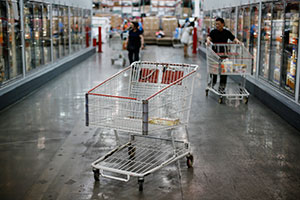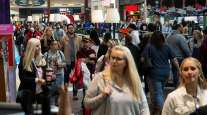Spending by Consumers Rises Less Than Expected

Consumer purchases rose less than projected in February, indicating the biggest part of the U.S. economy will find it hard to sustain momentum after the best quarter since 2006.
The 0.1% gain followed a 0.2% drop the prior month, Commerce Department figures showed March 30 in Washington. The median forecast of 74 economists in a Bloomberg News survey called for a 0.2% gain. Adjusted for inflation, spending declined for the first time in almost a year.
Frigid temperatures and snow in much of the Northeast and Midwest last month emptied malls and auto-dealer lots as Americans huddled at home to keep warm. While warmer weather may bring out shoppers, steady gains in payrolls have yet to foster bigger wage gains, which would help bolster spending.
“Consumer spending is looking soft here, some of it was the weather effect,” Tom Porcelli, chief U.S. economist at RBC Capital Markets in New York, the top spending forecaster over the past two years, according to data compiled by Bloomberg. Consumption “will come back in the second quarter.”
Projections for spending ranged from little changed to a 0.5% gain. The previous month’s reading was initially reported as a decline of 0.2%.
Incomes climbed 0.4% in February for a second month, propelled by a jump in dividends. The Bloomberg survey median called for incomes to rise 0.3%. The prior month’s income figure was previously reported as a 0.3% gain.
Wages and salaries increased 0.3% after a 0.6% gain in January.
The economy expanded at a 2.2% annualized rate in the fourth quarter, led by the biggest gain in consumer spending in eight years, revised Commerce Department data showed March 27. The 4.4% jump in household purchases was the most since the first three months of 2006 and reflected bigger outlays on health care than previously estimated.
Last quarter’s surge in purchases will be difficult to match this quarter as American consumers decided to squirrel away the extra cash from cheaper fuel. The saving rate increased to 5.8% last month, the highest since December 2012, from 5.5%.
The report also showed that adjusting consumer spending for inflation, which generates the figures used to calculate gross domestic product, purchases declined 0.1 %, the first drop since April, after a 0.2 % increase in the previous month.
Durable goods purchases, including automobiles, decreased 1.1% after adjusting for inflation, the worst performance since December 2013. Spending on non-durable goods, which include gasoline, was little changed.
The biggest surprise may have been outlays on services, which rose 0.1% after adjusting for inflation, the smallest gain since July. The category includes utilities, so economists were projecting a jump to help offset the weaker readings elsewhere.
Americans, especially those living in the eastern U.S., felt the pinch from higher heating bills that came due this month. Some 23 states had a top-10 coldest February and nine had their second-coldest, according to the National Oceanic and Atmospheric Administration. Residents in Chicago and Cleveland observed record-low February temperatures.
The cold weather also slowed showroom traffic, hurting car purchases. Ford Motor Co.’s light-vehicle sales slipped last month, while results at General Motors Co., Fiat Chrysler Automobiles NV, Honda Motor Co. and Nissan Motor Co. rose less than analysts estimated.
While gasoline prices advanced last month from a six-year low of $2.03 a gallon on Jan. 25, the nationwide average of $2.42 on March 29 was little changed from the end of February, according to figures from the motoring group AAA.
An improving job market continues to work in favor of consumers. February marked the 12th straight month that payrolls climbed by at least 200,000, and the jobless rate was the lowest in almost seven years, Labor Department data showed.
“The consumer is in decent shape,” Karen Hoguet, chief financial officer at department store chain Macy’s Inc., said during a March 24 conference presentation. At the same time, where customers are choosing to spend their money is “still going to be a challenge for retailers like us,” she said, citing electronics and cable services as alternate purchases.
The report also showed prices were stabilizing. The Federal Reserve’s preferred measure of inflation, the price gauge based on the personal consumption expenditures, increased 0.2% from the prior month, the first advance since September, and was up 0.3% from a year earlier.
The core price measure, which excludes food and fuel, rose 0.1% from the prior month and increased 1.4% from February 2014. The 1.3% year-to-year readings in January and December were the lowest since March 2014.
Inflation hasn’t been above the Fed’s 2% goal since March 2012.




